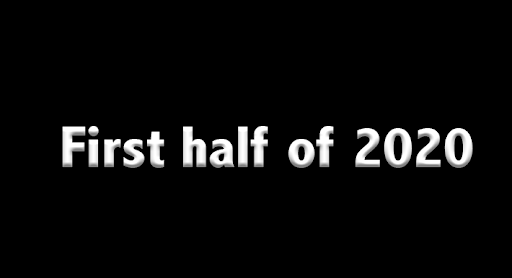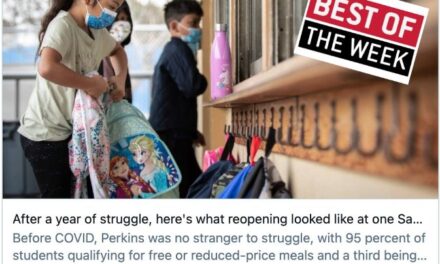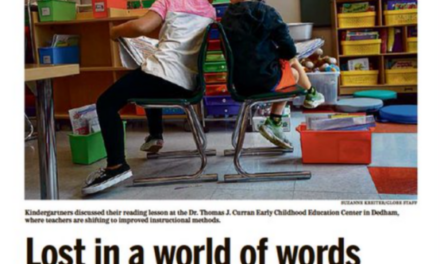Eight of the best — and most-read — critiques and first-person essays from The Grade from January through June. Plus a couple of reader favorites.
By Alexander Russo
Now that the first half of this very strange, endless, and amazing year is in the books, let’s take a look back at some of the best (and most-read) pieces published by The Grade during that time period.
They include some brutally honest self-reflections from current and former education journalists, some pointed critiques of major news outlets like the New York Times and Washington Post from me, and some first-person essays about what it’s like being an education journalist in 2020.
COVERING EDUCATION IN 2020
Working from home with children to supervise was a critical challenge for many education journalists in 2020, but a small number of reporters experienced furloughs and layoffs.
Furlough journal, Day 1: staring at the computer screen
Over five long days in April, Providence Journal education reporter Linda Borg described what it’s like being cut off from colleagues and stories that you care about enormously.
“I hate working from home. I miss the newsroom. I pray that the ‘new normal’ doesn’t become permanent.”
How to survive being laid off from your first newspaper job
Just eight months after being hired to cover education for the Austin American-Statesman, education reporter Aaricka Washington was laid off. She writes eloquently about the experience of moving across the country and putting her all into the job, only to have it snatched away just as she was hitting her stride.
“My work, and the future projects I dreamed to do with the organization, had been cut short. I, a young, black woman reporter from a working-class family, would be laid off from my very first professional journalism job.”
COVID COVERAGE
The year’s biggest coverage challenge was the sudden shutdown of school systems nationwide and the rise of remote learning.
No, asking questions about remote learning isn’t ‘teacher bashing’
The same week that she won a Pulitzer Prize for her amazing journalism, New York Times reporter Nikole Hannah-Jones was excoriated on social media for her comments and observations about the inadequacy of remote education, based largely on the notion that she engaged in “teacher bashing.”
“If the most prominent journalist writing about education in the nation can’t describe what’s happening without being swarmed by critics, denounced for ‘teacher bashing,’ and pressured to apologize for her observations, then who can?”
Four hours a day; how teacher contracts are shaping remote learning
As contributor Jenny Manrique reported, one of the most powerful but little-addressed determinants of remote learning programs were the teacher contracts and agreements that governed how much time teachers spent actively engaged with kids.
“What we found is that most districts guaranteed teachers’ pay and established a minimum number of hours within the 40-hour workweek for teachers to engage with students and parents.”
FIRST-PERSON SELF-REFLECTIONS
Some of the most valuable pieces that The Grade produces are columns in which reporters reflect on how they do their work or look back at past efforts.
Take it from me; reflections on covering a hazing death at a Florida HBCU
In this February piece, former education journalist Denise-Marie Ordway bravely reexamines her work that was much admired at the time and finds fault.
“I flubbed a rare opportunity to educate the country about HBCUs beyond the usual negative news headlines.”
Covering communities that are not your own
In this January piece resulting from her series about the decades-long inadequacy of education provided to Black kids in San Francisco, KALW education reporter Lee Romney reflects on writing about communities that are different from the one she comes from.
“Early on, I crafted an online survey for black parents and guardians to probe their experiences with the special ed system. No one filled it out.”
CONSTRUCTIVE CRITICISM
Even the top news outlets in the nation sometimes go awry with their coverage or stubbornly resist changing practices that no longer make sense. This year was no different.
3 steps to fix the Washington Post’s education section
The Washington Post’s education section is broken and has been for quite a while — despite having some of the nation’s best education reporters. There are at least three easy ways for the paper to sort things out, but doing so would mean reining in pageview champion Valerie Strauss.
“The section is a mess unlike any I’ve seen at any other major newspaper: confusing to readers, unfair to journalists and contributors, and nearly homogenous in the points of view it features.”
The disengaged kids missing from the New York Times’ remote learning coverage
For vulnerable kids in particular, this past spring’s remote learning experience was a disaster. Millions of kids were effectively left behind. But the New York Times has been missing in action on this crucial story, somehow unable or unwilling to put those kids’ experiences front and center.
“These kids are not dropouts. They’re not truants. They’re not statistics. They’re victims, and survivors — no less vulnerable and important than the kids who fled New Orleans or sheltered in place during Parkland. But in the Times, they have somehow become almost invisible.”
THE EDUCATION JOURNALISM BUSINESS
Making education journalism as strong and compelling as possible is increasingly challenging, given competing pressures and long-standing practices.
Newsroom diversity 2020; not nearly good enough
Though the original version of this piece was flawed, resulting in a correction from Poynter and several apologies from me, the core finding about the lack of diversity on the education beat remains inarguable and timely.
“Few education teams or outlets come anywhere near matching the racial diversity of K-12 students or the communities they’re covering. Meanwhile, transparency around newsroom demographics remains weak.”
8 ways to make education journalism more student-centered
There is a lot of what I call “teacher journalism” being produced by education reporters these days, which is not necessarily a bad thing unless it’s overdone. This column highlights ways reporters can make sure their work centers on the needs and experiences of kids, who are the most vulnerable stakeholders in the massive education system.
“Teachers are important. But from my perspective, education reporters should be practicing journalism that’s centered on the experiences and needs of students. Their experiences (and their voices) should be at the core.”
Related posts:
My 6 favorite columns so far in 2019
The 7 most memorable pieces of education journalism for 2019
The Grade’s most-read pieces of 2019
ABOUT THE AUTHOR

Alexander Russo
Alexander Russo is founder and editor of The Grade, an award-winning effort to help improve media coverage of education issues. He’s also a Spencer Education Journalism Fellowship winner and a book author. You can reach him at @alexanderrusso.
Visit their website at: https://the-grade.org/














